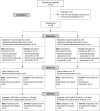Low-dose ketamine does not improve the speed of recovery from depression in electroconvulsive therapy: a randomized controlled trial
- PMID: 34076068
- PMCID: PMC8827368
- DOI: 10.1590/1516-4446-2020-1705
Low-dose ketamine does not improve the speed of recovery from depression in electroconvulsive therapy: a randomized controlled trial
Abstract
Objective: Electroconvulsive therapy (ECT) is a well-established therapeutic intervention for major depressive disorder. Recent literature has shown that the anesthetic agent ketamine has some antidepressant properties at low doses and may be an alternative therapy for treatment-resistant major depressive disorder. We hypothesized that the use of low-dose ketamine as an anesthetic adjunct in ECT would more rapidly improve depression while maintaining hemodynamic stability than ECT with propofol alone.
Methods: Institutional ethics approval was obtained, and the use of ketamine in this study was approved by Health Canada. This is a randomized, double-blinded, placebo-controlled trial that involved ketamine administration at 0.5 mg/kg IV in addition to propofol anesthesia for ECT. The primary outcome was the number of ECT treatments required to achieve a 50% reduction in the Montgomery-Asberg Depression Rating Scale (MADRS). Secondary outcomes included the number of ECT treatments required to achieve a 25% reduction in MADRS score, as well as any differences in the Clinical Global Impression Scale for Severity, hemodynamic variables, and seizure duration. Adverse events were recorded for safety assessment.
Results: A total of 45 patients completed the study. No difference was found between groups with respect to the primary or secondary outcomes. The ketamine group showed a trend towards a decreased dose of propofol required to achieve adequate anesthesia. No adverse events were reported.
Conclusion: Low-dose ketamine does not improve psychiatric outcomes in the setting of propofol-based anesthesia for ECT. Specifically, ketamine did not reduce the number of ECT sessions necessary to achieve a 50 or 25% reduction in MADRS scores. Reassuringly, the fact that no differences in hemodynamic variables or unexpected adverse events occurred suggests that low-dose ketamine may be safely used in this setting should clinical indications warrant its use.
Clinical trial registration: ClinicalTrials.gov, NCT02579642.
Conflict of interest statement
CM participated in the Regional Canadian Esketamine Advisory Board Meeting (AB-SK-MB, Feb 13 2019), which provided a clinical review of Esketamine, examined evidence for its use, and reviewed safety protocols. The other authors report no conflicts of interest.
Figures





Similar articles
-
Ketamine-based anesthesia improves electroconvulsive therapy outcomes: a randomized-controlled study.Can J Anaesth. 2018 Jun;65(6):636-646. doi: 10.1007/s12630-018-1088-0. Epub 2018 Feb 21. Can J Anaesth. 2018. PMID: 29700801 Clinical Trial. English.
-
A randomized clinical trial of adjunctive ketamine anesthesia in electro-convulsive therapy for depression.J Affect Disord. 2018 Feb;227:372-378. doi: 10.1016/j.jad.2017.11.034. Epub 2017 Nov 10. J Affect Disord. 2018. PMID: 29149755 Clinical Trial.
-
Effects of S-ketamine as an anesthetic adjuvant to propofol on treatment response to electroconvulsive therapy in treatment-resistant depression: a randomized pilot study.J ECT. 2013 Sep;29(3):158-61. doi: 10.1097/YCT.0b013e318283b7e9. J ECT. 2013. PMID: 23475029 Clinical Trial.
-
Comparison of the effect of intravenous anesthetics used for anesthesia during electroconvulsive therapy on the hemodynamic safety and the course of ECT.Psychiatr Pol. 2017 Dec 30;51(6):1039-1058. doi: 10.12740/PP/75635. Epub 2017 Dec 30. Psychiatr Pol. 2017. PMID: 29432502 Review. English, Polish.
-
Effects of Ketamine Anesthesia on Efficacy, Tolerability, Seizure Response, and Neurocognitive Outcomes in Electroconvulsive Therapy: A Comprehensive Meta-analysis of Double-Blind Randomized Controlled Trials.J ECT. 2020 Jun;36(2):94-105. doi: 10.1097/YCT.0000000000000632. J ECT. 2020. PMID: 31725054
Cited by
-
Bispectral Index versus the University of Michigan Sedation Scale in assessing sedation depth during pediatric drug-induced sleep endoscopy.Sleep Breath. 2024 Jun;28(3):1365-1372. doi: 10.1007/s11325-024-03022-3. Epub 2024 Mar 18. Sleep Breath. 2024. PMID: 38499834
-
Ketamine Augmentation of Electroconvulsive Therapy: A Scoping Review of Dose-Dependent Effects in Major Depressive Disorder.Cureus. 2023 Jun 7;15(6):e40087. doi: 10.7759/cureus.40087. eCollection 2023 Jun. Cureus. 2023. PMID: 37292107 Free PMC article.
-
Efficacy and safety of ketamine-assisted electroconvulsive therapy in major depressive episode: a systematic review and network meta-analysis.Mol Psychiatry. 2024 Mar;29(3):750-759. doi: 10.1038/s41380-023-02366-8. Epub 2023 Dec 20. Mol Psychiatry. 2024. PMID: 38123725
References
-
- Petrides G, Fink M, Husain MM, Knapp RG, Rush AJ, Mueller M, et al. ECT remission rates in psychotic versus nonpsychotic depressed patients: a report from CORE. J ECT. 2001;17:244–53. - PubMed
-
- Takano H, Motohashi N, Uema T, Ogawa K, Ohnishi T, Nishikawa M, et al. Differences in cerebral blood flow between missed and generalized seizures with electroconvulsive therapy: a positron emission tomographic study. Epilepsy Res. 2011;97:225–8. - PubMed
-
- Andrade C, Bolwig TG. Electroconvulsive therapy, hypertensive surge, blood-brain barrier breach, and amnesia: exploring the evidence for a connection. J ECT. 2014;30:160–4. - PubMed
Publication types
MeSH terms
Substances
Associated data
LinkOut - more resources
Full Text Sources
Medical
